You'll find several ethical alternatives to traditional musk in modern perfumery. Natural options include ambrette seed, hyraceum (Africa stone), and botanical resins like frankincense. For synthetic alternatives, try Ambrox, Civetone, or eco-friendly compounds like Galaxolide. You can also explore galbanum, angelica root, wool musk absolute, and essential oil blends. These cruelty-free ingredients open up a world of sophisticated fragrance possibilities waiting to be discovered.
Ambrette Seed: The Plant-Based Powerhouse of Musky Notes
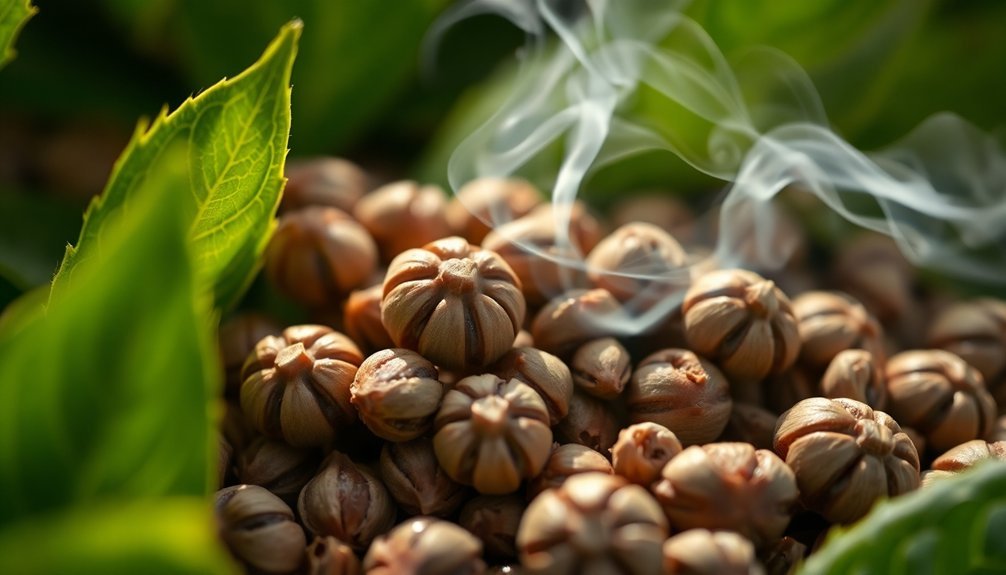
While perfumers have long sought ethical alternatives to animal-derived musk, ambrette seed has emerged as nature's answer to this challenge. Derived from the musk mallow plant, this powerful ingredient delivers an intensely rich, sweet, and musky-floral profile that rivals traditional animal musk.
You'll find ambrette seed's complex character includes notes of Cognac, tobacco, and iris, along with fruity undertones reminiscent of pear. The oil appears as a pale yellow liquid that may contain some natural particulates.
It's extracted through steam distillation or supercritical CO2 methods, producing either an essential oil or absolute. What makes it particularly valuable is its exceptional staying power and versatility – you can use it across various fragrance families, from citrus to oriental.
As a fixative, you'll need only small amounts to enhance your perfume's longevity and depth, making it both sustainable and cost-effective.
Synthetic Ambrox: Modern Innovation in Cruelty-Free Scents
Since traditional perfumery has relied heavily on animal-derived ingredients, Synthetic Ambrox represents a groundbreaking achievement in cruelty-free fragrance development.
You'll find this laboratory-created compound perfectly mimics the warm, ambery aroma of natural ambergris while offering superior consistency and cost-effectiveness.
When you choose perfumes containing Synthetic Ambrox, you're supporting sustainable practices and ethical innovation in the fragrance industry.
It's not just about avoiding animal products – you're also getting a more stable, long-lasting scent.
This synthetic alternative blends seamlessly with other fragrance ingredients, making it versatile for various perfume formulations.
As part of the "green chemistry" movement, it's helping transform the industry by providing a sustainable solution that doesn't compromise on quality or performance. The development of these alternatives has enabled brands like Medeau Safara to create delicate, sophisticated scents using bioidentical ingredients.
Hyraceum: Nature's Ancient Musk Alternative
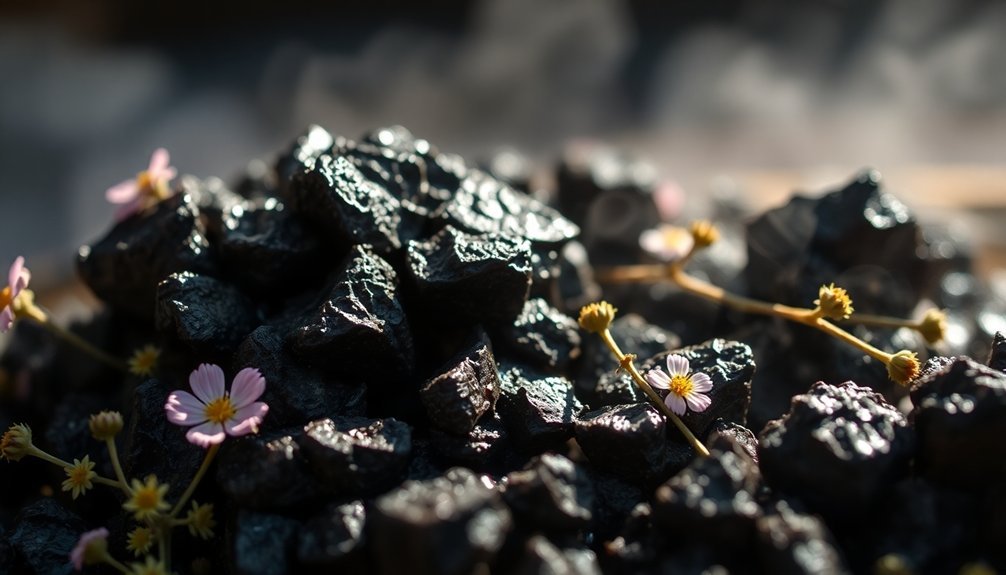
Among nature's most fascinating musk alternatives, hyraceum stands out as an ancient perfumery ingredient with a remarkable origin.
You'll find this "Africa Stone" in caves where Rock Hyrax excrement has transformed over time into a dark, rock-like material. It's a sustainable and cruelty-free option that delivers a complex aroma profile combining notes of musk, tobacco, and agarwood. Like traditional musk, it serves as an excellent fixative for volatiles.
When you experience hyraceum in perfumes, you'll notice:
- A grounded, ethereal fragrance that adds sophistication
- A potent scent requiring only minimal amounts
- A unique woody resonance that enhances other ingredients
Perfumers extract this ancient treasure by crushing the collected stones and creating a resinoid absolute or tincture, offering you an ethical alternative to traditional animal-derived musks.
Essential Oil Blends for Complex Musky Accords
When crafting complex musky accords, you'll want to start by layering floral base notes like ambrette seed with earthy vetiver to establish a rich foundation.
You can enhance the blend's complexity by combining woody elements like agarwood with bright citrus notes, creating an interplay between deep and fresh aromatics.
The final dimension comes from incorporating deep resinous oils like copaiba balsam and gurjun balsam, which add lasting depth and warmth to your natural musk alternative.
Layering Floral Base Notes
Creating complex musky accords begins with the strategic layering of floral base notes. You'll want to start with your musky base layer first, as it acts as an anchor for the entire fragrance composition.
When adding floral notes, choose complementary scents like rose or wild bouquets that enhance rather than compete with the musk. Remember to apply heavier scents before lighter ones to maintain balance and prevent any single note from dominating.
- Picture a delicate dance between powdery musk and fresh rose petals, creating an ethereal cloud of scent
- Imagine the warmth of ambrette seed embracing wild jasmine in perfect harmony
- Envision layers of fragrance unfolding like silk scarves in a gentle breeze
Don't overconcentrate on any single note; instead, let each layer develop naturally over time for a beautifully balanced blend.
Combining Woods With Citrus
The art of combining woods with citrus takes your musky accord to new aromatic heights.
Start by selecting bright citrus oils like sweet orange, grapefruit, or lemon for your top notes. These will provide an initial burst of freshness that gradually reveals the deeper wood elements beneath.
Layer your chosen citrus with rich woods like cedarwood, sandalwood, or agarwood. You'll want to use these potent wood oils sparingly – they're powerful and can quickly overwhelm the delicate citrus notes.
Begin with just a drop or two of cedarwood paired with 4-5 drops of citrus oil. As you develop your blend, add vetiver or patchouli to anchor the scent and extend its longevity.
Remember to test frequently and adjust your ratios until you've achieved the perfect balance between bright citrus and deep, woody undertones.
Deep Resinous Oil Pairings
Deep resinous oils form the backbone of any sophisticated musky accord, providing the rich complexity that synthetic musks often lack.
You'll find that combining patchouli with vetiver creates a grounding base, while agarwood adds luxurious depth. To achieve balance, layer in benzoin's sweet vanilla notes and copaiba balsam's smooth woody aroma.
When crafting your blend, consider these sensory experiences:
- A walk through an ancient forest after rain, where earth and wood merge
- Precious resins burning in an oriental temple at dusk
- Aged leather and tobacco in a vintage leather armchair
Don't forget to incorporate complementary notes like ambrette seed and ginger fresh to lift the deeper tones.
Remember to dilute your blend properly and use high-quality ingredients to guarantee a stable, long-lasting fragrance.
Botanical Resins and Their Rich Musky Undertones
Natural botanical resins provide a rich tapestry of musky undertones, offering perfumers and aromatherapists ethical alternatives to traditional animal-derived musks. You'll find exceptional depth in frankincense varieties, from the rare green grade's sherbet notes to the amber's deep pine-musky profile.
| Resin Type | Key Characteristics |
|---|---|
| Green Frankincense | Light, sherbet lemon, rare |
| Royal Frankincense | Fresh citrus, light color |
| Amber Frankincense | Musky pine, sweet citrus |
| Socotran Myrrh | Heavy musk, spicy warmth |
When you're crafting artisanal perfumes, these resins offer sustainable options that don't compromise on complexity. The darker varieties excel in incense applications, while lighter grades provide therapeutic benefits through their boswellic acids. By choosing these botanical resins, you're supporting sustainable harvesting practices while achieving the desired musky depth in your fragrance compositions.
Sustainable Patchouli and Sandalwood Combinations
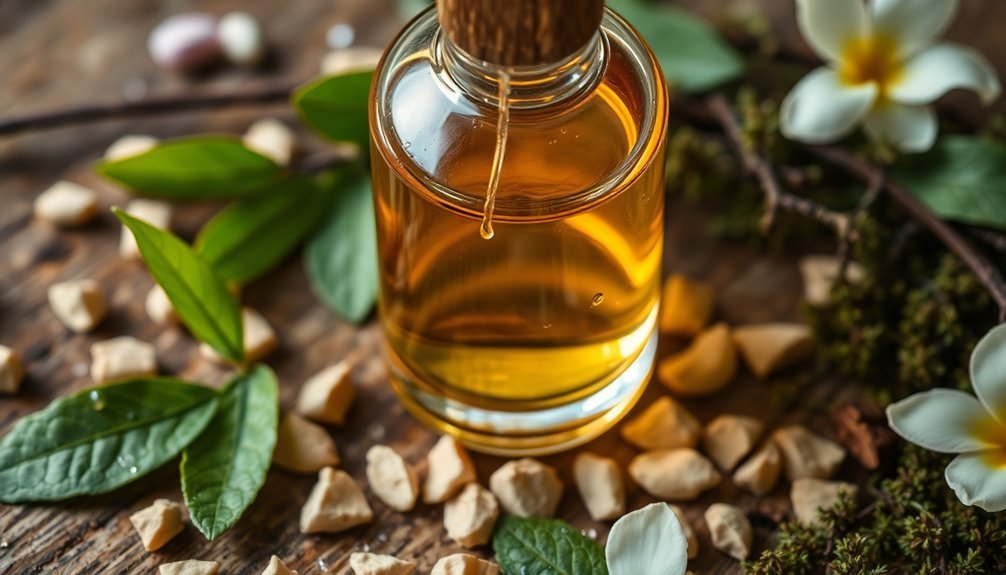
While patchouli offers earthy depth on its own, combining it with sustainably sourced sandalwood creates an extraordinary fusion of woody and oriental notes.
You'll find that selecting sustainably harvested sandalwood not only preserves this precious resource but also guarantees the purest, most authentic fragrance profile.
When blending these two ingredients, you're supporting responsible forestry practices that protect trees until they reach full maturity at 15-20 years.
- Picture walking through an ancient forest where earthy patchouli mingles with warm, creamy sandalwood
- Imagine the rich, grounding aroma that emerges when these two ingredients dance together
- Envision the sustainable harvest process, where each mature tree removed is replaced by new saplings
This ethical combination delivers a luxurious, long-lasting scent while protecting our planet's fragrant treasures for future generations.
Civetone: The Ethical Evolution of Classic Musk
You'll find that civetone, a synthetic molecule created to replicate natural civet musk, represents a groundbreaking advancement in ethical fragrance development.
This cruelty-free alternative captures the warm, animalic notes of traditional civet while eliminating the need for animal-derived ingredients.
When you use fragrances containing civetone, you're embracing both innovation and compassion in modern perfumery.
Synthetic Creation and Innovation
As the fragrance industry evolves, synthetic musks have revolutionized perfumery by offering cruelty-free alternatives that maintain the alluring qualities of traditional musk.
You'll find advanced chemical compounds like Galaxolide and Tonalide that deliver consistent, controlled scent profiles while supporting ethical sourcing practices.
Through sophisticated laboratory processes, these synthetic alternatives provide both accessibility and sustainability for modern perfume creation.
- Picture a pristine laboratory where chemists precisely engineer molecular structures to capture the essence of natural musk
- Envision sophisticated extraction equipment drawing aromatic compounds from sustainable botanical sources
- Imagine sleek production facilities creating biodegradable musk alternatives at scale
These innovations don't just replicate natural musk—they're transforming the industry with cost-effective, environmentally conscious solutions that meet today's ethical standards while preserving the artistry of perfumery.
Fragrance Profile and Applications
Through innovative advancements in perfumery, synthetic civetone has emerged as a cornerstone of ethical musk production, delivering the enchanting depth of traditional civet musk without animal exploitation.
You'll find this cruelty-free alternative offers the same animalic, musky notes perfumers have prized for centuries, while being more cost-effective and environmentally conscious.
When blending artisanal perfumes, you can combine synthetic civetone with botanical alternatives like ambrette seed and labdanum to create complex, layered fragrances.
These natural ingredients add warmth and earthiness while maintaining ethical standards. For oriental and chypre fragrances, labdanum's rich, resinous character pairs beautifully with synthetic musks, creating the depth and sophistication luxury perfumes demand.
This versatile combination lets you craft unique scent profiles that honor traditional perfumery while embracing modern values.
Natural Absolutes for Deep Musky Foundations
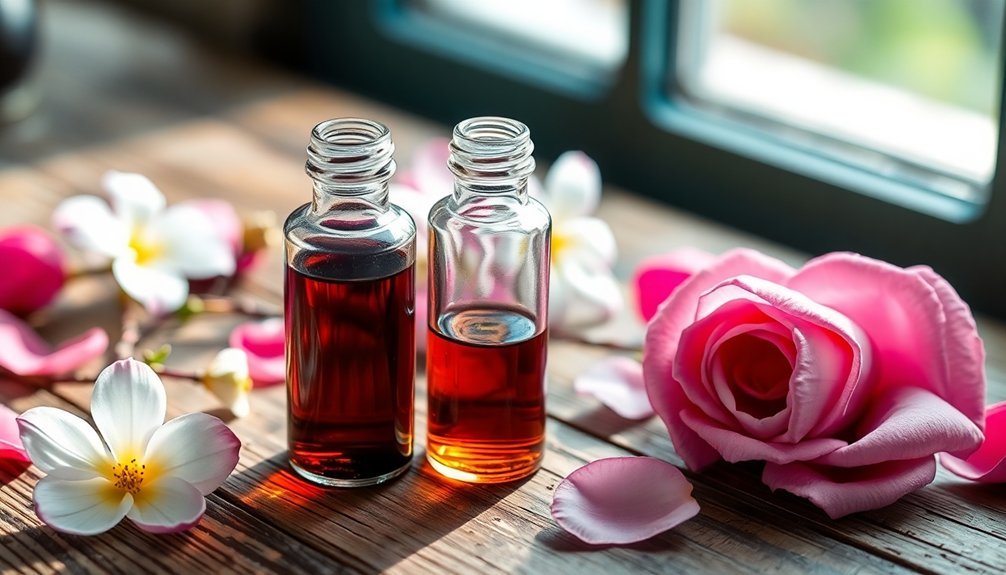
While traditional musk fragrances often relied on cruel animal harvesting practices, modern perfumery has embraced ethical alternatives like wool musk absolute and hyraceum to create deep, animalic foundations.
You'll find these natural absolutes offer complex, rich bases that rival traditional musks while maintaining ethical standards. They're particularly effective when you're crafting perfumes that need lasting power and depth.
- Wool musk absolute captures the warm, intimate scent of clean sheep's wool with subtle leathery undertones.
- Hyraceum provides an earthy, concentrated musk note from fossilized droppings without harming living creatures.
- Ambrette seed delivers a sweet, warm muskiness reminiscent of aged wine and flower petals.
These natural absolutes work beautifully in alcohol-based formulations and blend seamlessly with woody, floral, and leather accords to create sophisticated fragrances.
Galbanum and Angelica Root Musk Alternatives
Today's artisanal perfumers have discovered two powerhouse botanical ingredients that rival traditional musk: galbanum and angelica root.
You'll find galbanum's pungent, bitter aroma creates a unique sensuality, while angelica root offers a softer, more subtle musky note through its 15-Pentadecanolide content.
Both ingredients serve as sustainable, cruelty-free alternatives that'll enhance your perfume's longevity.
When you're creating custom blends, you can use galbanum to add depth and complexity, or angelica root to achieve warm, musky undertones without animalic characteristics.
You'll appreciate how these botanicals blend seamlessly with other ingredients, allowing you to craft distinctive fragrances that align with ethical perfumery practices.
Whether you're developing niche scents or bespoke compositions, these alternatives provide the perfect foundation for modern, conscious perfumery.
Eco-Friendly Synthetic Musks in Modern Perfumery
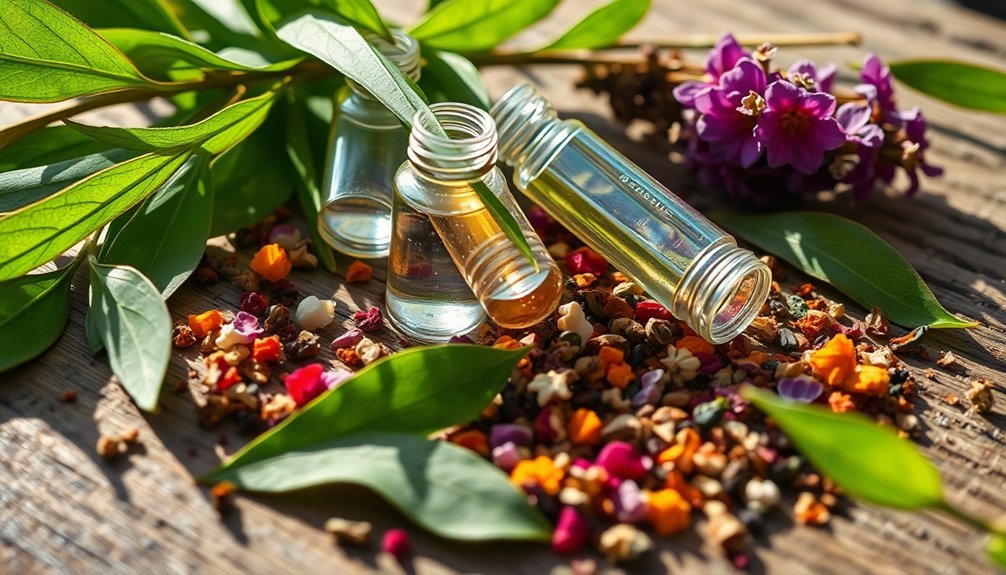
As perfumers seek sustainable alternatives to animal-derived ingredients, synthetic musks have emerged as a cornerstone of eco-friendly fragrance creation.
You'll find these cruelty-free compounds in various forms, from macrocyclic musks that mirror natural scent molecules to modern alternatives like Galaxolide and Habanolide.
They're not only ethical but also offer consistent, predictable results in your perfume formulations.
- Picture a pristine laboratory where scientists craft clean, sweet musk notes without a single animal harmed.
- Imagine perfectly measured drops of synthetic musk creating identical batches of your favorite perfume.
- Envision sustainable fragrance production that protects endangered musk deer in their natural habitats.
These synthetic options deliver precise scent profiles while supporting environmentally responsible practices in modern perfumery.
Frequently Asked Questions
How Long Do Natural Musk Alternatives Typically Last Compared to Synthetic Ones?
You'll find natural musk alternatives typically last several hours, while synthetic musks can endure for days. Without fixatives, you'll need to reapply natural alternatives more frequently to maintain the desired scent strength.
Can People With Sensitive Skin Safely Use All Musk Alternatives?
No, you can't safely use all musk alternatives if you have sensitive skin. Botanical musks are your safest option, while synthetic musks may cause irritation. Always patch test before using any new fragrance.
What's the Average Price Difference Between Synthetic and Natural Musk Alternatives?
You'll find synthetic musk alternatives are typically $10-60, while natural options cost $100-150+. You're looking at roughly a $90 difference on average between the two, with synthetics being more budget-friendly.
Do Natural Musk Alternatives Work Well in Hot Climate Conditions?
You'll find that botanical musks like ambrette seeds work effectively in hot climates, maintaining their scent well. While they're generally stable, synthetic alternatives like Ambrettolide and Ambroxan often provide better longevity in heat.
How Should Artisanal Perfumes With Natural Musk Alternatives Be Stored?
Store your artisanal perfumes in dark glass bottles at a cool temperature (15-20°C), away from sunlight. Keep them upright, tightly sealed, and in a low-humidity environment to maintain their unique scent profile.
In Summary
You'll find these 10 cruelty-free musk alternatives revolutionize your approach to artisanal perfumery. Whether you're crafting with plant-based ambrette seed or experimenting with synthetic ambrox, you've got ethical options that don't compromise on quality. As you blend these alternatives into your creations, you're not just making exceptional fragrances – you're contributing to a more sustainable and compassionate future in perfumery.


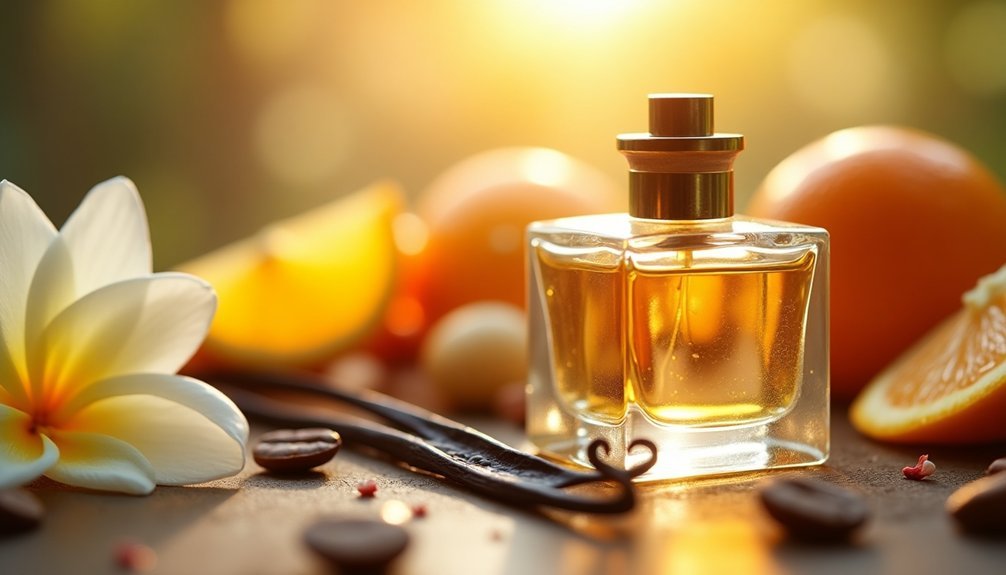

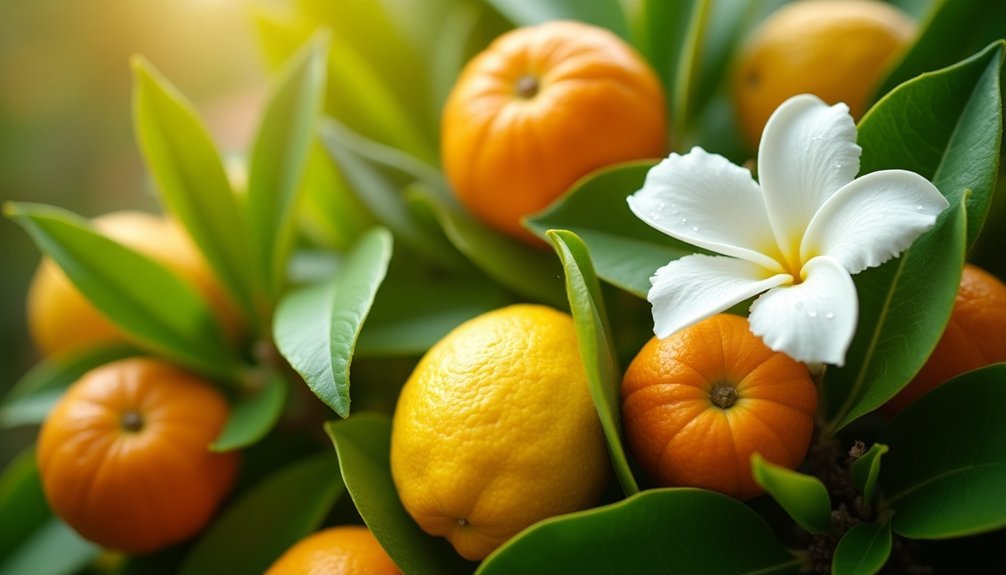
Leave a Reply